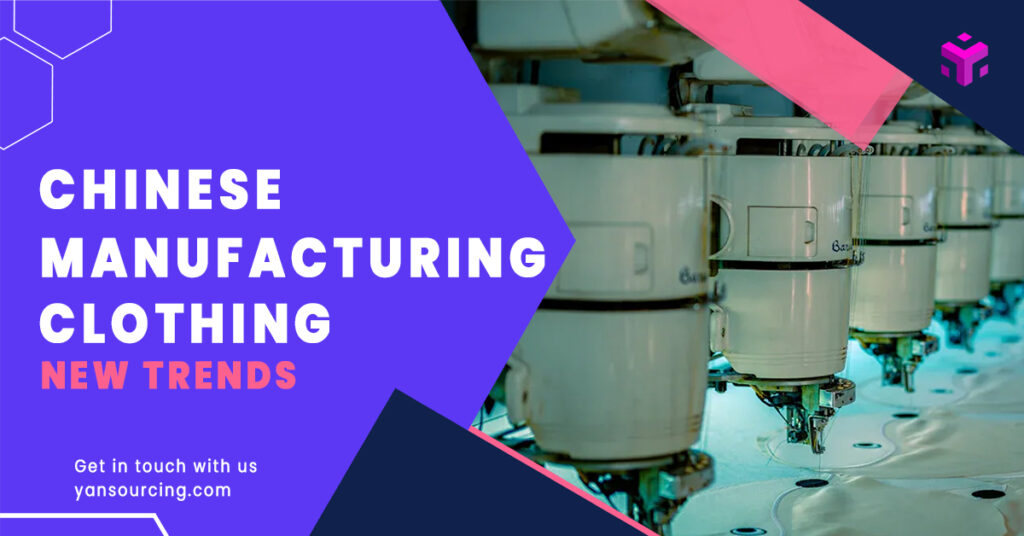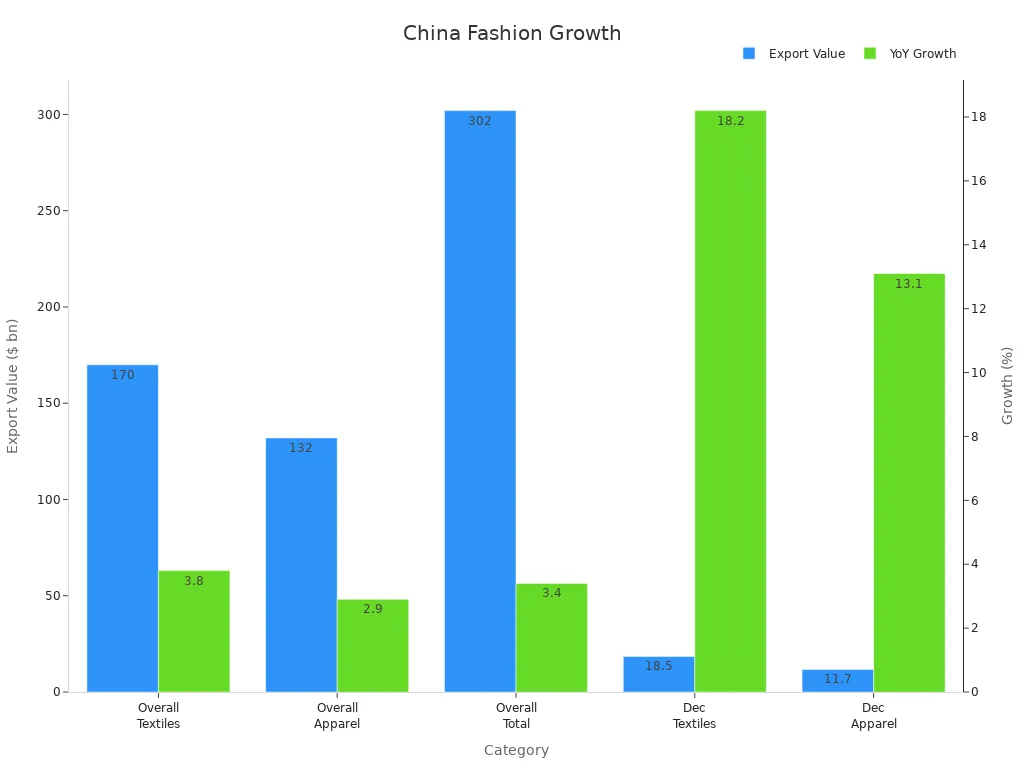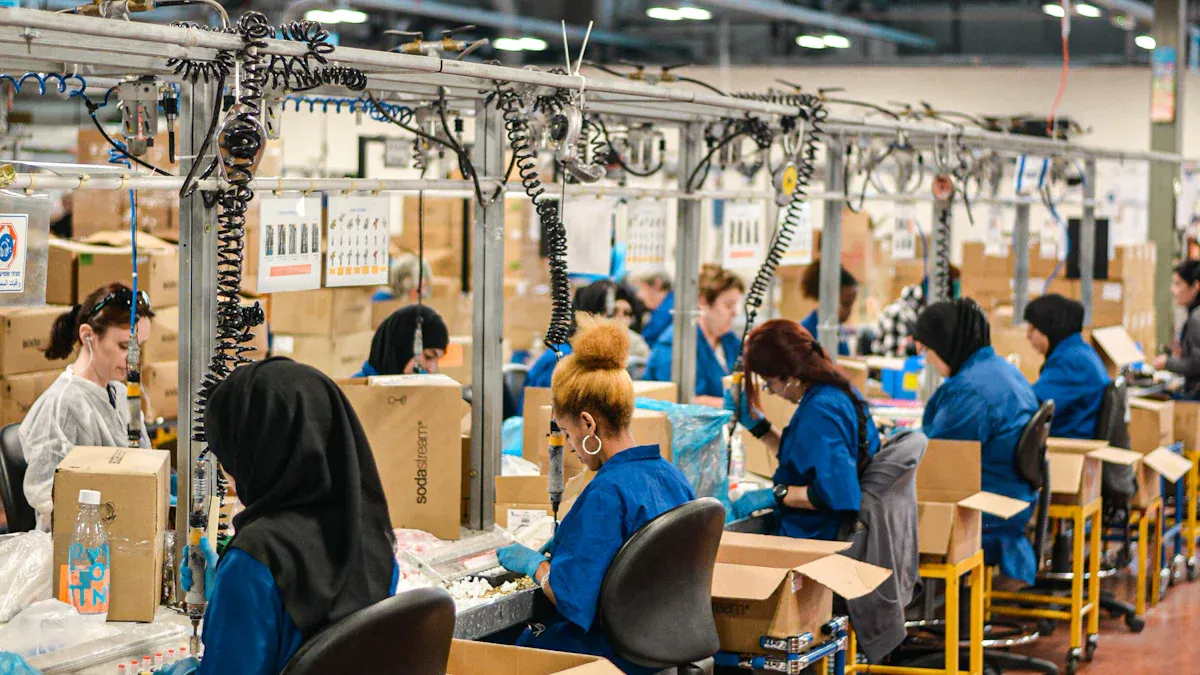
Have you seen how Chinese manufacturing clothing has evolved? They don’t only produce large quantities of garments anymore. Now, they focus on creating high-quality, custom outfits to meet new market demands. For instance, companies like KTC now specialize in unique clothing, demonstrating that innovation and quality are essential. Rising costs and global competition have prompted factories to adapt. Some, like HongTao Bags, have even launched their own premium brands. This transformation highlights how China’s clothing industry leverages creativity and flexibility to maintain its success.
Key Takeaways
Chinese clothing factories now make high-quality, custom clothes instead of mass-producing items.
New technology like robots, AI, and 3D printing helps factories make unique designs faster and easier.
Factories care more about the environment, using green materials and methods to attract eco-friendly buyers.
They focus on special markets, like sportswear and fancy clothes, to match what certain shoppers want.
Working with global suppliers improves fabric and design quality, making sure products are top-notch.
Companies such as Yansourcing help connect brands with trusted factories for custom clothing needs.
Online shopping makes it simple for people to buy custom clothes, making shopping more fun and personal.
With more competition, Chinese factories work on new ideas and better quality to stay leaders in the world market.
Historical Context of Chinese Manufacturing Clothing
China’s Role as the “World’s Factory”
The rise of mass production in the apparel and fashion industry
Do you know why China is called the “World’s Factory“? It began with making clothes in huge amounts. In the 1980s, China’s clothing industry grew very fast. Factories made lots of clothes at low prices. This made Chinese clothing popular with global brands.
From 1980 to 2008, the clothing industry’s value rose from $4.2 billion to $140 billion. It grew by 13.3% each year on average. In 1985, the industry grew by 46%, jumping from $6.1 billion to $89 million. These numbers show how quickly China became a leader in making clothes.
How low-cost production shaped global demand
Making clothes cheaply changed everything. It helped China lead the world market. Brands everywhere chose Chinese factories for affordable clothes. This boosted exports and made China the top choice for clothing production.
Here’s a table to show China’s impact:
Category | Data |
|---|---|
Market Size (2024) | Estimated at $294.4 billion |
Revenue Growth Rate (CAGR) | 0.3% over the past five years |
Export Market Growth Rate | Average rate of 1.7% in the next five years |
Total Wages (2024) | Anticipated to be $39.5 billion |
These numbers show how cheap production helped China lead the clothing industry worldwide.
The Growth of the Apparel and Fashion Industry in China
Export-oriented policies and their impact on production
China’s government helped this growth happen. They made rules to focus on selling goods to other countries. These rules made China a leader in clothing exports. In 2024, China’s textile and clothing exports reached $302 billion. Textiles made up $170 billion, and clothing made up $132 billion.

This chart shows how exports kept growing, making China important in the global clothing market.
The evolution of manufacturing practices over decades
China’s factories have changed a lot over time. They now use better tools and smarter machines. Automation and quality checks are common. These changes help factories meet customer needs and keep quality high.
Factories also make more money now. In 1998, the average profit per factory was 621,000 Yuan. By 2010, it grew to 3,076,000 Yuan. This shows how the industry has improved and succeeded over the years.
Challenges in the Chinese Apparel and Fashion Industry
Rising Labor Costs in China
The move from low wages to higher pay
China was once known for cheap labor. That has changed now. Wages in China are rising faster than in other Asian countries. Workers have more job choices, especially in cities. This has pushed wages even higher. For example:
Since 2011, the textile industry slowed, so companies raised wages to keep workers.
This change makes it harder for factories to stay cheap and competitive.
How this affected China’s clothing industry
Higher wages made foreign brands look for cheaper places to make clothes. Countries like Vietnam and Bangladesh became popular choices. To compete, Chinese factories use automation and better technology. Some factories moved to cheaper areas in Western and Middle China. These changes help factories keep up with global needs.
Global Competition in the Apparel Industry
New manufacturing hubs are growing
China faces tough competition in making clothes. Other countries are stepping up. For example:
Vietnam’s share of global clothing exports grew from 5% in 2014 to 9.8% in 2023.
Bangladesh’s share rose from 4.2% in 2014 to over 7.1% in 2023.
Brands now get clothes from India, Pakistan, and Myanmar. Rising costs in China and world events caused this shift. The global clothing market is clearly changing.
How China stays strong in the industry
China is working hard to stay on top. Factories focus on new ideas and being efficient. Automation helps reduce the need for many workers. Some factories make luxury or eco-friendly clothes to stand out. These plans help China stay important in the clothing business.
Sustainability and Ethical Concerns
Solving environmental and worker problems in fashion
Sustainability is very important in fashion today. People want clothes made in fair and eco-friendly ways. In China, some companies are using greener methods. For example, they use eco-friendly materials and share supply chain details. These steps help the planet and build customer trust.
Why sustainable practices are in demand
More brands now talk about being sustainable. This is not just a trend; it’s needed. A study in Shandong Province showed people care about how brands treat the planet and workers. When brands share their efforts, customers trust them more and buy their products. Sustainability helps both the Earth and businesses.
The Shift to High-Quality Custom Solutions in Chinese Manufacturing
Advanced Technology in Apparel Production
How automation, AI, and 3D printing help customization
Have you seen how technology is changing clothing production? In China, factories now use automation, AI, and 3D printing to make custom clothes. These tools help factories work faster and more accurately. For example, 3D printing makes prototypes quickly, saving time and money. AI studies trends and guesses what styles you might like next. This helps factories design clothes that fit your taste.
Factories also use Quick Response methods to handle custom orders better. They can make small batches of high-quality clothes without delays. These changes show how Chinese factories are focusing on personalized clothing.
How technology improves speed and quality
Technology doesn’t just make things faster; it also makes them better. Machines now work with great accuracy, so clothes meet high standards. Predictive maintenance keeps machines running smoothly, avoiding breakdowns. Here’s a table showing how technology helps:
Technology Type | How It Helps Production |
|---|---|
Robotics | Speeds up work and increases productivity. |
Automated Machines | Makes clothes with precision and less waste. |
Predictive Maintenance | Stops machine problems before they happen. |
Automated Quality Checks | Finds mistakes better than people can. |
These tools help factories make high-quality custom clothes that you’ll love.
Focus on Premium Materials and Quality
Using eco-friendly and durable fabrics
Have you heard about the need for sustainable clothes? Chinese factories now use fabrics that are good for the planet and last longer. These materials feel nice to wear and reduce harm to the environment. Factories are also taking back control of fabric production to ensure better quality. This helps them meet your demand for eco-friendly and high-quality clothing.
Working with global suppliers for better fabrics
To give you better materials, Chinese factories team up with global suppliers. These partnerships bring in top-quality fabrics and creative designs. By working with trusted suppliers, factories make clothes that look great and last long. This focus on quality and sustainability is changing the clothing industry.
Targeting Niche Markets in Fashion
Specializing in activewear and luxury clothing
Chinese factories now focus on specific markets like activewear and luxury clothes. Activewear needs fabrics that are light, breathable, and strong. Whether you do yoga or play sports, these clothes are made for you. Luxury clothing is another area where factories shine, offering stylish and exclusive designs.
Making clothes based on your preferences
Factories are also creating clothes that match what you like. They study what different groups of people want and design clothes for them. For example, luxury brands like Louis Vuitton attract people who want high-quality and stylish items. By paying attention to these details, Chinese factories make clothes that feel personal to you.
Case Studies: Success Stories in Chinese Manufacturing Clothing
Yansourcing’s Role in Custom Clothing Solutions
How Yansourcing helps new and big clothing brands
Have you thought about how brands find good clothing partners? Yansourcing is a trusted company for this. They help new and big brands work with Chinese factories. Yansourcing makes sure the factories are reliable and check the quality of clothes. They also handle shipping, making everything easier and saving money.
Yansourcing offers custom options to make your clothes unique. They can add logos or create special designs for you. Even if you order a small number of items, they can help. Their team knows a lot about clothing and ensures your ideas come to life.
Examples of successful projects in clothing
Yansourcing has helped many brands succeed. One example is their work with a British company to make perfume bottle covers for a French luxury brand. While not about clothes, it showed their skill in managing tough projects. They made 10,000 covers in just 55 days. This shows how Yansourcing is great at handling detailed and fast work for brands.
Moving from Mass Production to Luxury Fashion
A company’s journey to making high-end clothes
Switching from making lots of cheap clothes to luxury ones is hard. But some Chinese companies have done it well. For example, one factory used to make fast fashion in bulk. They decided to focus on luxury activewear instead. By using better materials and new technology, they changed their business. Now, they make limited-edition clothes for people who want high-quality items.
They also started using eco-friendly fabrics and recycling waste. One project recycled military uniforms to cut carbon emissions. These changes helped the environment and made the company more respected worldwide.
How focusing on luxury improves a brand’s image
Specializing in luxury fashion makes a brand look better. It shows they care about quality and unique designs. This attracts customers who pay more for special clothes. For companies, this shift means higher profits and loyal customers. It’s good for both the brand and its buyers.
Building In-House Brands in China
Factories creating their own clothing brands
Did you know some Chinese factories now have their own brands? Instead of just making clothes for others, they create their own lines. These brands often focus on things like eco-friendly or luxury streetwear. Factories use their skills to make products as good as global brands.
One factory started a brand for eco-friendly activewear. They used their fabric and design knowledge to make clothes for people who care about the planet. This helped them grow their business and connect directly with customers.
Why having their own brand helps factories grow
Starting their own brand has many benefits. Factories can control their products and prices better. They become more than just suppliers—they compete in the global market. It also helps them stand out and earn more money. For Chinese factories, this is a smart way to grow and succeed.
The Role of Technology and Innovation in the Future of Chinese Manufacturing

Smart Manufacturing in the Apparel Industry
Using IoT and data to improve production
Have you thought about how factories make clothes smarter? In China, factories now use IoT (Internet of Things) and data to work better. IoT devices watch machines and track every step. This helps find and fix problems quickly. Data also helps by showing ways to make things faster and smoother.
For example, IoT sensors can tell when a machine might break. This stops delays and keeps work going. Factories also use RFID tags to follow clothing items during production. These tools help factories stay on time and make high-quality clothes.
Benefit | How It Helps |
|---|---|
Find Problems | |
Avoid Machine Breakdowns | Predict repairs to stop sudden issues. |
Use Resources Better | Change processes based on live data for more efficiency. |
Make Smarter Choices | Use real-time data instead of old information to decide faster. |
Watching machines and fixing them before they break
Real-time monitoring means watching machines all the time. It helps factories see problems right away. Predictive maintenance goes further. It guesses when machines need fixing before they break. This saves time and avoids surprises.
Chinese factories are leading with these ideas. They use smart fabrics, sensors, and automated systems to work faster. This saves time and ensures the clothes you buy are top quality.
Sustainable Practices in Chinese Manufacturing Clothing
New ways to make eco-friendly clothes
Sustainability is very important now. Chinese factories are finding greener ways to make clothes. They use eco-friendly fabrics and recycle materials to cut waste. Some even use solar power for their machines.
Factories also use the C2M (consumer-to-manufacturer) model. This connects you directly to factories, skipping extra steps. It’s good for you and the planet.
Why reusing materials matters for the future
Have you heard of circular fashion? It means reusing old materials to make new clothes. This idea is growing in China. Factories design clothes that are easy to recycle. This reduces waste and helps the environment.
By focusing on circular fashion, Chinese factories protect the planet and meet your need for sustainable clothes. It’s a step toward a greener future.
E-Commerce and Direct-to-Consumer Models
How online shopping helps custom orders and global sales
Online shopping has changed how you buy clothes. E-commerce lets you order custom outfits from anywhere. Chinese factories use these platforms to connect with you. You can get unique designs or perfect fits easily.
With billions of people on social media, brands use it to reach you. Social media helps you find new styles and even design your own clothes. This makes shopping fun and personal.
How digital marketing promotes better clothing options
Digital marketing is key in online shopping. It helps brands show their best products and why they’re worth buying. For example, most marketers say social media helps people notice their brands. This means you can find high-quality clothes online.
Chinese factories use these tools to share their custom options. They study what you like and make shopping easier for you. This makes your experience better and more enjoyable.
Conclusion
China’s clothing industry has changed a lot over time. It used to focus on making huge amounts of clothes. Now, it creates custom outfits that match people’s unique styles. Today, China makes more than half of the world’s textiles and over 30% of global clothing exports. Factories now help brands design clothes that are special and different.
This big change didn’t happen quickly. New technology, like smart machines and AI, made production faster and better. Companies also care more about the planet. They use eco-friendly materials and green methods to please customers who care about the environment. Trends like online shopping and custom designs show that staying creative is key to success.
Companies such as Yansourcing help in this progress. They connect brands with trusted factories and offer custom solutions. This helps businesses grow in a fast-changing market. As the industry keeps improving, creativity, technology, and caring for the planet will shape the future of Chinese clothing manufacturing.
FAQ
1. Why is China a top clothing maker?
China leads because of its modern machines and skilled workers. It also has strong factories and supply systems, making it great for global brands.
2. Can Chinese factories make small custom orders?
Yes, many factories can handle small orders. They offer custom options like adding logos or special designs, even for small amounts.
3. How do Chinese factories keep quality high?
They use smart tools like automated checks and machine care. Factories also follow strict rules to meet global quality standards.
4. Are Chinese clothing exports still popular?
Yes, even with higher costs, China stays strong. Factories focus on new ideas, better materials, and special markets to stay ahead.
5. Do Chinese factories care about the environment?
Yes! Many now use eco-friendly fabrics, recycle materials, and follow green methods to make clothes.
6. How does technology help Chinese factories?
Factories use robots, AI, and 3D printing to work faster and better. These tools help make high-quality clothes quickly.
7. Can small businesses work with Chinese factories?
Yes, small businesses often team up with agents like Yansourcing. These agents find good factories, handle shipping, and check quality.
8. Why are special markets important for Chinese factories?
Special markets like sportswear and luxury clothes let factories focus on unique items. This helps them attract customers who want something different and high-quality.

